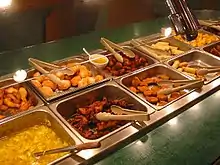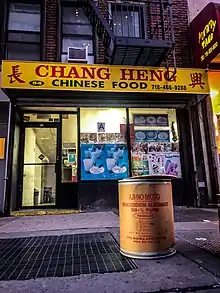Chinese restaurant
A Chinese restaurant is an establishment that serves a Chinese cuisine. Most of them are in the Cantonese style, due to the history of the Chinese diaspora and adapted to local taste preferences, as in the American Chinese cuisine and Canadian Chinese cuisine. The Chinese restaurants in the Netherlands usually combine Cantonese and Indonesian meals on their menu. Chinese takeouts (United States and Canada) or Chinese takeaways (United Kingdom and Commonwealth) are terms to describe the act of ordering the meal(s) with the intent to eat the food at another location, such as at work or home. It can be found either as a service option of eat-in establishments or as separate establishments.



History
United States
Chinese restaurants in the United States began during the California gold rush, which brought twenty to thirty thousand immigrants across from the Canton (Kwangtung or Guangdong) region of China. The first documented Chinese restaurant opened in 1849 as the Canton Restaurant.[1] By 1850, there were five restaurants in San Francisco. Soon after, significant amounts of food were being imported from China to America's west coast. The trend spread eastward with the growth of the American railways, particularly to New York City.[2] At the ratification of the Chinese Exclusion Act of 1882 there were only 14 restaurants in San Francisco.[1] However, the Chinese Exclusion Act allowed merchants to enter the country, and in 1915 restaurant owners became eligible for merchant visas. This fueled the opening of Chinese restaurants as an immigration vehicle.[3] The Chinese Exclusion Act forced Chinese immigrants to move away from wage work to self employment through laundries and restaurants.[4] As of 2015, the United States had 46,700 Chinese restaurants.[5]
There has been a consequential component of Chinese emigration of illegal origin, most notably Fuzhou people from Fujian Province[6] and Wenzhounese from Zhejiang Province in Mainland China, specifically destined to work in Chinese restaurants in New York City, beginning in the 1980s. Adapting Chinese cooking techniques to local produce and tastes has led to the development of American Chinese cuisine. Many of the Chinese restaurant menus in the U.S. are printed in Chinatown, Manhattan.[7]
United Kingdom
In the early 1880s, Chinese food items and eating houses appeared in London and Liverpool, mainly visited by Chinese seamen and students.[8]
In 1884, Chinese food was made available as part of an exhibition featuring a 'restaurant' in the International Health Exhibition in South Kensington, London.[9]
In 1907[10] or 1908,[8] the first recorded Chinese restaurant was opened in London. The rise in the number of Chinese restaurants in the UK only began after the Second World War, and has been attributed to returning service personnel from Hong Kong.[9] The restaurants were operated by Hong Kongers who moved to the UK.[11] One restaurant that stands out in the history of Chinese restaurants in the UK is the Kuo Yuan which in 1963 was the first restaurant to serve Peking duck.
In 2003, the first British Chinese restaurant achieved a Michelin star.[12] In the United Kingdom, the business employed a large percentage of Chinese immigrants in the 1980s (90% in 1985).[13] Opening a restaurant or takeaway gave a relatively low capital cost entry for Chinese families into self-employment.[14] Many takeaways served a pseudo-Chinese cuisine based around western tastes, and the limited cooking skills and experience of the shop owners.[14][15]
In 2011, the Ming-Ai (London) Institute launched the British Chinese Food Culture project with a grant from the Heritage Lottery Fund, aimed at exploring and tracking the changes in Chinese food throughout its history in the United Kingdom.[16][8]
The 2020 coronavirus pandemic has negatively impacted many Chinese restaurants in the UK, with a number of restaurants in London's Chinatown in particular facing financial difficulty,[17] due to lockdown restrictions and social distancing as well as prejudice against Chinese takeaways which the BBC describe as "unfounded".[17]
Australia
At the beginning of the 21st century, Chinese restaurants had been present in a significant majority of Australian cities and towns for over fifty years, and in many places for over one hundred and fifty years.[18]
They emerged as commercial enterprises on the Victorian gold fields.[19]
The significant majority of original Chinese migration came from Kwangtung Province in southern China, heavily influencing the style of food, consisting of fresh vegetables and fruit, with fish, poultry, and pork, with rice, herbs and spices.[20]
One third of all cooks in Australia were Chinese by 1890.[18][21]
Netherlands
There are many Chinese restaurants in the Netherlands,[22] although the number has fallen in the decade preceding 2019.[23] The first Chinese restaurant opened in the 1920s.[24] Chinese food in the Netherlands is often inspired by Indonesian cuisine owing to the Netherlands' colonisation of Indonesia.[22]
In 2019, it was reported that the previous decade had seen a 22% decline in the number of Chinese-Indonesian restaurants in the Netherlands, whereas the number of other restaurants increased by 15%.[25] Researchers attributed this to Chinese restaurants not meeting "modern" desires of consumers, including outdated décor and fatty food considered unappealing to an increasingly health-conscious population.[23]
In 2020, a number of Chinese restaurants began trialling the use of service robots, including in Renesse[26] and Maastricht.[27]
A study published in 2019 raised concerns regarding labour trafficking in Chinese restaurants in the country, due to the migrants' "vulnerability to exploitation" and urged protection for migrants against "extreme forms of labour exploitation" seen across Europe.[28]
Germany
In 1928, one of Germany's first Chinese restaurants opened in the Kantstraße region of Berlin, known for its large Chinese community.[29]
By 1966, there were 100 Chinese restaurants across Germany; in 1992 this had increased to over 3,000.[29]
Today, Chinese restaurants can be found throughout Germany to the extent that, in 2016, almost every German city with a population of over 15,000 has at least a single Chinese restaurant.[29] The largest concentration is found in Berlin[30] where restaurants have been known to pair traditional Szechuan- and Shanghai-inspired dishes with German wines.[31] Many students from China and Hong Kong studying in Germany open Chinese restaurants.[32]
Egypt
The majority of Egypt's Chinese restaurants are found in Cairo, described by Slate in 2015 as "Shanghai on the Nile" due to its burgeoning Chinese food scene.[33]
In 2000, periodical Flavor and Fortune recorded between 7 and 8 restaurants in Cairo and around "a dozen" in the country, although the number was increasing.[34]
In 2020, Egypt's Health Ministry launched a campaign aimed at inspecting Chinese restaurants over food safety concerns in light of the COVID-19 epidemic,[35] however Egypt denied reports that premises were being raided.[36]
See also
References
| Wikimedia Commons has media related to Chinese style restaurants. |
- LIU, HAIMING; Ling, Huping (2015). From Canton Restaurant to Panda Express: A History of Chinese Food in the United States. Rutgers University Press. ISBN 9780813574752. JSTOR j.ctt16nzfbd.
- Smith, Andrew F. (2009). Eating history: 30 turning points in the making of American cuisine. Columbia University Press. p. 47. ISBN 978-0-231-14092-8.
- Godoy, Maria (23 February 2016). "Lo Mein Loophole: How U.S. Immigration Law Fueled A Chinese Restaurant Boom". NPR. Retrieved 23 February 2016.
- Carter, Susan B. (28 January 2011), "America's First Culinary Revolution, or How a Girl from Gopher Prairie Came to Dine on Eggs Fooyung", Economic Evolution and Revolution in Historical Time, Stanford University Press, pp. 419–446, doi:10.11126/stanford/9780804771856.003.0016, ISBN 9780804771856, S2CID 107967493
- Passy, Charles (26 August 2015). "Meet the Pilot Who Doubles as Block Island's Chinese-Food Delivery Guy". The Wall Street Journal. pp. A1. Retrieved 26 August 2015.
- "Chinese Immigrants Chase Opportunity in America". NPR Morning Edition. 19 November 2007. Retrieved 9 July 2011.
- "20 Secrets of Your Local Chinese Takeout Joint". The Daily Meal. Archived from the original on 24 September 2017. Retrieved 24 September 2017.
- "British Chinese Food - - 英國中餐 - British Chinese Heritage Centre - British Chinese Heritage Centre". British Chinese Heritage Centre (in Chinese). Retrieved 15 June 2020.
- Sukhadwala, Sejal (12 April 2017). "How Long Have Londoners Been Eating Chinese Food For?". Londonist. Retrieved 14 June 2020.
- "Chinese diaspora in Britain" (PDF). British Museum. Archived from the original (PDF) on 2 June 2011. Retrieved 22 June 2011.
- "Chinese restaurants 1950." British Library. Retrieved on 26 November 2016.
- Milmo, Cahal (17 January 2003). "Chinese restaurant takes away Michelin star". The Independent. London. Retrieved 22 June 2011.
- Sinn, Elizabeth (1998). The last half century of Chinese overseas. Hong Kong University Press. p. 429. ISBN 9789622094468.
- J.A.G. Roberts (2004). China to Chinatown: Chinese Food in the West. Reaktion Books. pp. 175–181. ISBN 9781861892270.
- Wai Kam Yu (Joseph Rowntree Foundation) (2000). Chinese older people: a need for social inclusion in two communities. The Policy Press. pp. 6–7. ISBN 9781861342423.
- "BRITISH CHINESE FOOD CULTURE". Ming Ai London. Retrieved 15 June 2020.
- Gillett, Victoria Lindrea & Francesca (3 February 2020). "Coronavirus fear hits London's Chinatown". BBC News. Retrieved 15 June 2020.
- Heanue, Siobhan (21 February 2016). "Chinese restaurants in Australia documented for posterity by historians". ABC News. Australian Broadcasting Corporation. Retrieved 29 April 2018.
- Nichol, Barbara. "Sweet and sour history: Melbourne's early Chinese restaurants" (PDF). National Archives of Australia. Archived from the original (PDF) on 22 April 2018. Retrieved 29 April 2018.
- "Australia's first Chinese restaurant, 1854". Defining Moments in Australian History. National Museum Australia. Retrieved 29 April 2018.
- "CHINESE FOOD CULTURE". Experience China. National Library of Australia. Retrieved 30 April 2018.
- "Chinese Food in Holland". Chinese Food. Retrieved 15 June 2020.
- "Off the menu. Old-style Chinese restaurants no longer popular". DutchNews.nl. 2 October 2019. Retrieved 15 June 2020.
- "Chinese restaurants". Faculteit der Ruimtelijke Wetenschappen. Retrieved 15 June 2020.
- "De 'traditionele Chinees' verliest het van de nieuwe, gezonde Aziatische keuken". Spronsen (in Dutch). 30 September 2019. Retrieved 15 June 2020.
- "Restaurant in the Netherlands to use robots to help out waiters". euronews. 10 June 2020. Retrieved 15 June 2020.
- Editorial, Reuters (4 June 2020). "Robots dish out the drinks at reopened Dutch restaurant". U.S. Retrieved 15 June 2020.
- van Meeteren, Masja; Wiering, Ellen (2019). "Labour trafficking in Chinese restaurants in the Netherlands and the role of Dutch immigration policies. A qualitative analysis of investigative case files". Crime, Law and Social Change. Springer Science and Business Media LLC. 72 (1): 107–124. doi:10.1007/s10611-019-09853-6. ISSN 0925-4994.
- Benton, G.; Pieke, F.N. (2016). The Chinese in Europe. Palgrave Macmillan UK. pp. 198–200. ISBN 978-1-349-26096-6. Retrieved 15 June 2020.
- "Authentic Chinese Food Is Easy to Find in Berlin". WSJ. 28 March 2003. Retrieved 15 June 2020.
- "In Berlin, Chinese Food Meets German Wine". The New York Times. 9 September 2010. Retrieved 15 June 2020.
- "Recruitment costs for Chinese workers in EU Member States" (PDF). International Organization for Migration (PDF). 2018. Retrieved 15 June 2020.
- Berger, Miriam (16 January 2015). "A Tour of Cairo's Surprisingly Rich Chinese Food Scene". Slate Magazine. Retrieved 15 June 2020.
- "On Menus: In Egypt". Chinese Food. Retrieved 15 June 2020.
- "Health Ministry launches campaigns to check Chinese restaurants in Egypt". EgyptToday. 15 June 2020. Retrieved 15 June 2020.
- "Egypt denies raiding Chinese restaurants to tackle coronavirus". Middle East Monitor. 30 January 2020. Retrieved 15 June 2020.